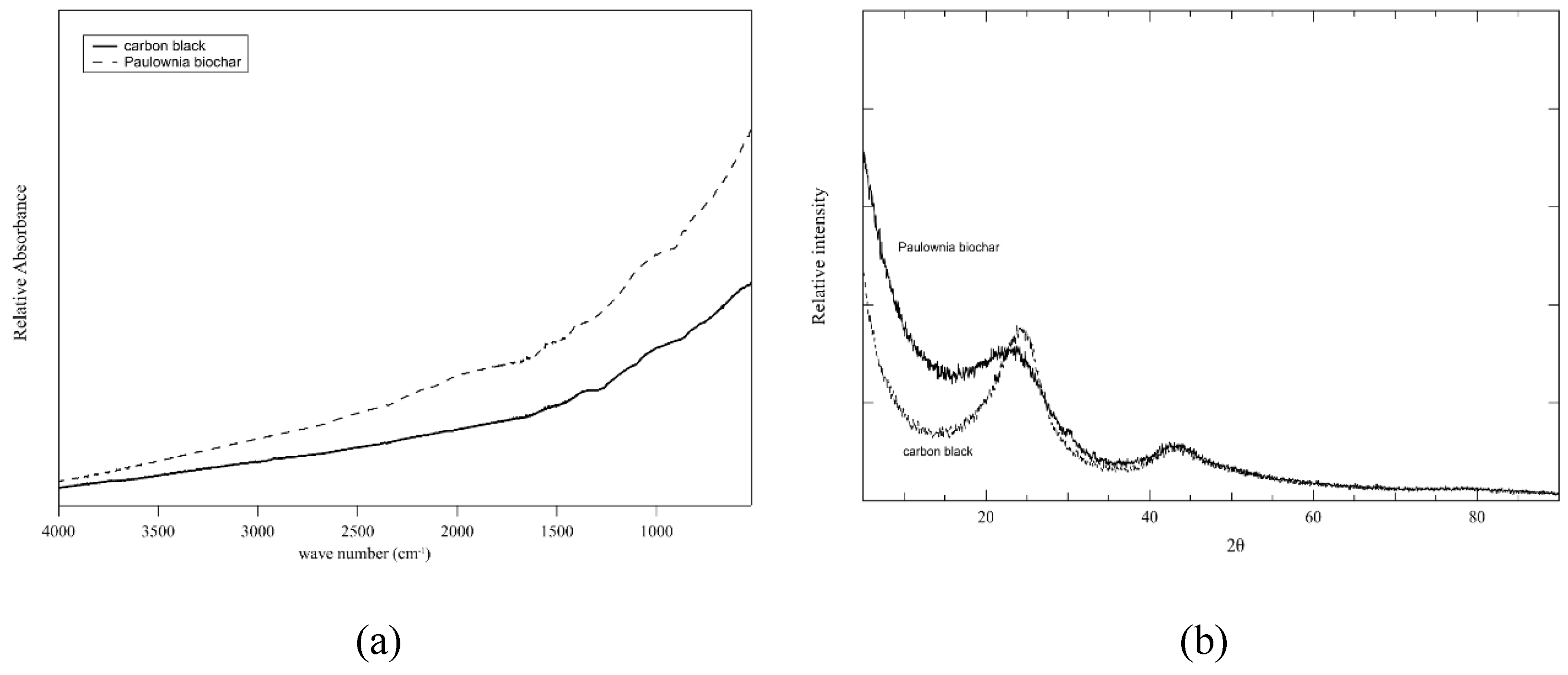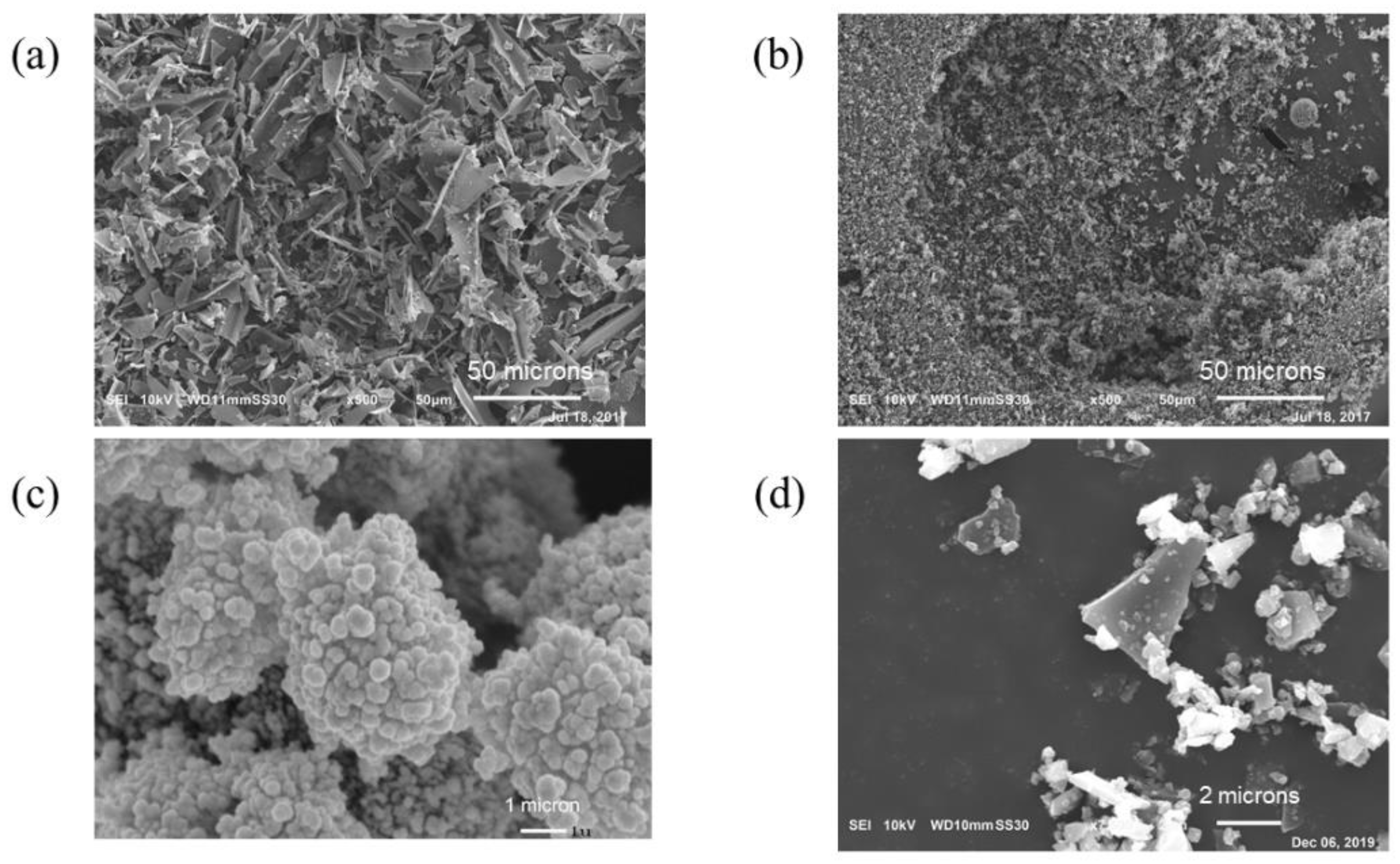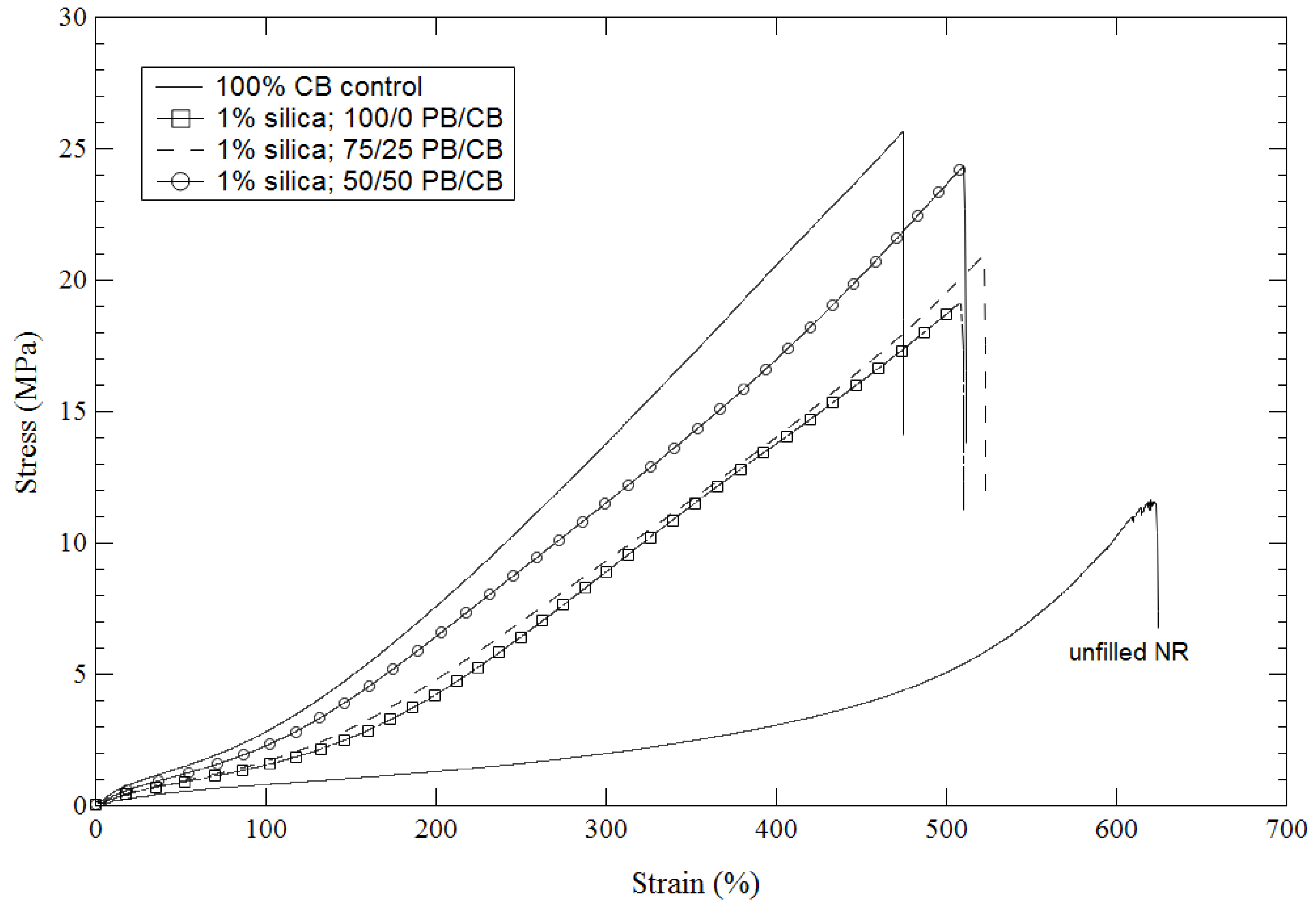Silica-Milled Paulownia Biochar as Partial Replacement of Carbon Black Filler in Natural Rubber
Abstract
1. Introduction
2. Materials and Methods
2.1. Materials Used
2.2. Chemical and Physical Material Properties
2.3. Formation of Rubber Composites and Tensile Testing
3. Results
3.1. Biochar Characterization
3.2. Composite Properties
4. Conclusions
Funding
Acknowledgments
Conflicts of Interest
References
- An Unknown Object, the Tire: Materials. Available online: Thetiredigest.michelin.com/an-unknown-object-the-tire-materials (accessed on 6 September 2019).
- Spahr, M.; Rothon, R. Carbon black as a polymer filler. In Polymers and Polymeric Composites: A Reference Series, 1st ed.; Palsule, S., Ed.; Springer: Berlin/Heidelberg, Germany, 2016; Volume 4, pp. 1–31. ISSN 2510-3458. [Google Scholar]
- Lehmann, J.; Joseph, S. Biochar for Environmental Management: Science and Technology, 2nd ed.; Routledge: New York, NY, USA, 2015; p. 976. ISBN 0415704154. [Google Scholar]
- Mukome, F.N.D.; Zhang, X.; Silva, L.C.R.; Six, J.; Parikh, S.J. Use of chemical and physical characteristics to investigate trends in biochar feedstocks. J. Agric. Food Chem. 2013, 61, 2196–2204. [Google Scholar] [CrossRef] [PubMed]
- Demirbas, A. Effects of temperature and particle size on bio-char yield from pyrolysis of agricultural residues. J. Anal. Appl. Pyrolysis 2004, 72, 243–248. [Google Scholar] [CrossRef]
- Yadav, N.K.; Vaidya, B.N.; Henderson, K.; Lee, J.F.; Stewart, W.W.; Dhekney, S.A.; Joshee, N. A review of Paulownia biotechnology: A short rotation, fast growing multipurpose bioenergy tree. Am. J. Plant Sci. 2014, 4, 2070–2082. [Google Scholar] [CrossRef]
- Basu, C.; Joshee, N.; Gezalian, T.; Vaidya, B.N.; Satidkit, A.; Hemmati, H.; Perry, Z.D. Cross-species PCR and field studies on Paulownia elongata: A potential bioenergy crop. Bioethanol 2016, 2, 12–23. [Google Scholar] [CrossRef]
- Jiménez, L.; Rodríguez, A.; Ferrer, J.L.; Pérez, A.; Angulo, V. Paulownia, a fast-growing plant, as a raw material for paper manufacturing. Afinidad 2005, 62, 100–105. [Google Scholar]
- Paulownia Growing Zones. Available online: worldpaulownia.com/growing-zones (accessed on 6 September 2019).
- Ayrilmis, N.; Kaymakci, A. Fast growing biomass as reinforcing filler in thermoplastic composites: Paulownia elongata wood. Ind. Crop. Prod. 2013, 43, 457–464. [Google Scholar] [CrossRef]
- Vaughn, S.F.; Kenar, J.A.; Tisserat, B.; Jackson, M.A.; Joshee, N.; Vaidya, B.N.; Peterson, S.C. Chemical and physical properties of Paulownia elongata biochar modified with oxidants for horticultural applications. Ind. Crop. Prod. 2017, 97, 260–267. [Google Scholar] [CrossRef]
- Peterson, S.C. Utilization of low-ash biochar to partially replace carbon black in styrene-butadiene rubber composites. J. Elastomers Plast. 2013, 45, 487–497. [Google Scholar] [CrossRef]
- Peterson, S.C.; Chandrasekaran, S.R.; Sharma, B.K. Birchwood biochar as partial carbon black replacement in styrene–butadiene rubber composites. J. Elastomers Plast. 2015, 48, 305–316. [Google Scholar] [CrossRef]
- Peterson, S.C.; Kim, S. Reducing biochar particle size with nanosilica and its effect on rubber composite reinforcement. J. Polym. Environ. 2019. [Google Scholar] [CrossRef]
- Gent, A.N.; Pulford, C.T.R. Micromechanics of fracture in elastomers. J. Mater. Sci. 1984, 19, 3612–3619. [Google Scholar] [CrossRef][Green Version]
- Peterson, S.C.; Joshee, N. Co-milled silica and coppiced wood biochars improve elongation and toughness in styrene-butadiene elastomeric composites while replacing carbon black. J. Elastomers Plast. 2018, 50, 667–676. [Google Scholar] [CrossRef]
- Darmstadt, H.; Roy, C.; Kaliaguine, S.; Xu, G.; Auger, M.; Tuel, A.; Ramaswamy, V. Solid state 13C-NMR spectroscopy and XRD studies of commercial and pyrolytic carbon blacks. Carbon 2000, 38, 1279–1287. [Google Scholar] [CrossRef]
- Difference between Conductive, Dissipative, Insulative, and Antistatic. Available online: Transforming-technologies.com/esd-fyi/difference-between-conductive-dissipative-and-insulative/ (accessed on 27 November 2019).
- Tisserat, B.; Joshee, N.; Mahapatra, A.K.; Selling, G.W.; Finkenstadt, V.L. Physical and mechanical properties of extruded poly(lactic acid)-based Paulownia elongata biocomposites. Ind. Crop. Prod. 2013, 44, 88–96. [Google Scholar] [CrossRef]
- Tisserat, B.; Reifschneider, L.; Joshee, N.; Finkenstadt, V.L. Properties of high density polyethylene—Paulownia wood flour composites via injection molding. BioResources 2013, 8, 4440–4458. [Google Scholar] [CrossRef]
- Tisserat, B.; Reifschneider, L.; Joshee, N.; Finkenstadt, V.L. Evaluation of Paulownia elongata wood polyethylene composites. J. Thermoplast. Compos. Mater. 2013, 28, 1301–1320. [Google Scholar] [CrossRef]
- Kaygin, B.; Kaplan, D.; Aydemir, D. Paulownia tree as an alternative raw material for pencil manufacturing. BioResources 2015, 10, 3426–3433. [Google Scholar] [CrossRef]
- He, T.; Vaidya, B.N.; Perry, Z.D.; Parajuli, P.; Joshee, N. Paulownia as a medicinal tree: Traditional uses and current advances. Eur. J. Med. Plants 2016, 14, 1–15. [Google Scholar] [CrossRef]
- Kalaycioglu, H.; Deniz, I.; Hiziroglu, S. Some of the properties of particleboard made from Paulownia. J. Wood Sci. 2005, 51, 410–414. [Google Scholar] [CrossRef]
- Lopez, F.; Perez, A.; Zamudio, M.A.M.; de Alva, H.E.; García, J.C. Paulownia as raw material for solid biofuel and cellulose pulp. Biomass Bioenergy 2012, 45, 77–86. [Google Scholar] [CrossRef]
- Vaughn, S.F.; Dinelli, F.D.; Tisserat, B.; Joshee, N.; Vaughan, M.M.; Peterson, S.C. Creeping bentgrass growth in sand-based root zones with or without biochar. Sci. Hortic. 2015, 197, 592–596. [Google Scholar] [CrossRef]



| Filler Composition | NR | TMQ | 6PPD | CB | PB | Stearic Acid | ZnO | Sulfur | CBTS |
|---|---|---|---|---|---|---|---|---|---|
| unfilled NR | 46.66 | 0.23 | 0.23 | 0 | 0 | 0.93 | 2.33 | 1.17 | 0.47 |
| 100% CB | 39.19 | 0.20 | 0.20 | 16.79 | 0 | 0.78 | 1.96 | 0.98 | 0.39 |
| 0% silica/100% PB | 38.43 | 0.19 | 0.19 | 0 | 16.47 | 0.77 | 1.92 | 0.96 | 0.38 |
| 0.5% silica/100% PB | 38.43 | 0.19 | 0.19 | 0 | 16.47 | 0.77 | 1.92 | 0.96 | 0.38 |
| 1% silica/100% PB | 38.43 | 0.19 | 0.19 | 0 | 16.47 | 0.77 | 1.92 | 0.96 | 0.38 |
| 2% silica/100% PB | 38.43 | 0.19 | 0.19 | 0 | 16.47 | 0.77 | 1.92 | 0.96 | 0.38 |
| 1% silica-75/25% PB/CB | 38.62 | 0.19 | 0.19 | 4.14 | 12.41 | 0.77 | 1.93 | 0.97 | 0.39 |
| 1% silica-50/50% PB/CB | 38.81 | 0.19 | 0.19 | 8.31 | 8.31 | 0.78 | 1.94 | 0.97 | 0.39 |
| Filler | Silica (%) | n | CB Replaced (%) | Tensile Strength (MPa) | Elongation (%) | Toughness (MPa) | Young’s Modulus (MPa) |
|---|---|---|---|---|---|---|---|
| Unfilled NR | 0 | 6 | N/A | 11.9 ± 1.2 | 626 ± 9 | 19.4 ± 1.6 | 1.2 ± 0.1 |
| 100% CB | 0 | 6 | 0 | 25.7 ± 0.6 | 476 ± 8 | 51.7 ± 2.3 | 3.9 ± 0.4 |
| 100% PB | 0 | 9 | 100 | 15.3 ± 1.6 | 522 ± 21 | 32.2 ± 4.7 | 1.9 ± 0.3 |
| 100% PB | 0.5 | 5 | 100 | 18.9 ± 0.7 | 516 ± 10 | 39.3 ± 2.2 | 2.2 ± 0.3 |
| 100% PB | 1 | 6 | 100 | 19.3 ± 0.9 | 519 ± 8 | 40.1 ± 2.3 | 2.2 ± 0.3 |
| 100% PB | 2 | 9 | 100 | 17.3 ± 1.2 | 469 ± 20 | 32.4 ± 3.9 | 2.3 ± 0.4 |
| 75/25% PB/CB | 1 | 6 | 75 | 21.0 ± 0.9 | 524 ± 11 | 43.9 ± 2.6 | 2.2 ± 0.2 |
| 50/50% PB/CB | 1 | 6 | 50 | 24.3 ± 0.4 | 527 ± 12 | 52.3 ± 1.4 | 2.8 ± 0.3 |
| Sample | Average G′ (MPa) |
|---|---|
| Unfilled NR | 0.256 ± 0.001 |
| 100% CB | 1.18 ± 0.02 |
| 100% PB–0% Si | 0.397 ± 0.001 |
| 100% PB–0.5% Si | 0.362 ± 0.002 |
| 100% PB–1% Si | 0.357 ± 0.001 |
| 100% PB–2% Si | 0.410 ± 0.001 |
| 75/25 PB/CB | 0.445 ± 0.003 |
| 50/50 PB/CB | 0.609 ± 0.004 |
© 2019 by the author. Licensee MDPI, Basel, Switzerland. This article is an open access article distributed under the terms and conditions of the Creative Commons Attribution (CC BY) license (http://creativecommons.org/licenses/by/4.0/).
Share and Cite
Peterson, S.C. Silica-Milled Paulownia Biochar as Partial Replacement of Carbon Black Filler in Natural Rubber. J. Compos. Sci. 2019, 3, 107. https://doi.org/10.3390/jcs3040107
Peterson SC. Silica-Milled Paulownia Biochar as Partial Replacement of Carbon Black Filler in Natural Rubber. Journal of Composites Science. 2019; 3(4):107. https://doi.org/10.3390/jcs3040107
Chicago/Turabian StylePeterson, Steven C. 2019. "Silica-Milled Paulownia Biochar as Partial Replacement of Carbon Black Filler in Natural Rubber" Journal of Composites Science 3, no. 4: 107. https://doi.org/10.3390/jcs3040107
APA StylePeterson, S. C. (2019). Silica-Milled Paulownia Biochar as Partial Replacement of Carbon Black Filler in Natural Rubber. Journal of Composites Science, 3(4), 107. https://doi.org/10.3390/jcs3040107





